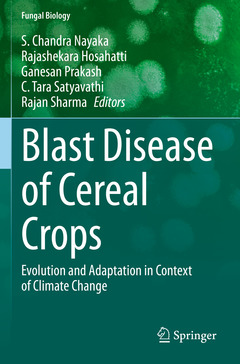Description
Blast Disease of Cereal Crops, 1st ed. 2021
Evolution and Adaptation in Context of Climate Change
Fungal Biology Series
Coordinators: Nayaka S. Chandra, Hosahatti Rajashekara, Prakash Ganesan, Satyavathi C. Tara, Sharma Rajan
Language: English
Subjects for Blast Disease of Cereal Crops:
Blast Disease of Cereal Crops
Publication date: 04-2022
219 p. · 15.5x23.5 cm · Paperback
Publication date: 04-2022
219 p. · 15.5x23.5 cm · Paperback
Blast Disease of Cereal Crops
Publication date: 04-2021
219 p. · 15.5x23.5 cm · Hardback
Publication date: 04-2021
219 p. · 15.5x23.5 cm · Hardback
Description
/li>Contents
/li>Biography
/li>Comment
/li>
Blast is an important foliar disease that infects the majority of cereal crops like rice, finger millet, pearl millet, foxtail millet and wheat, and thus resulting in a huge economic impact. The pathogen is responsible for causing epidemics in many crops and commonly shifts to new hosts. Magnaporthe spp. is the most prominent cause of blast disease on a broad host range of grasses including rice as well as other species of poaceae family. To date, 137 members of Poaceae hosting this fungus have been described in Fungal Databases.
This book provides information on all blast diseases of different cereal crops. The pathogen evolves quickly due to its high variability, and thus can quickly adapt to new cultivars and cause an epidemic in a given crop. Some of the topics covered here include historical perspectives, pathogen evolution, host range shift, cross-infectivity, and pathogen isolation, use of chemicals fungicides, genetics and genomics, and management of blast disease in different cereal crops with adoption of suitable methodologies.
In the past two decades there have been significant developments in genomics and proteomics approaches and there has been substantial and rapid progress in the cloning and mapping of R genes for blast resistance, as well as in comparative genomics analysis for resolving delineation of Magnaporthe species that infect both cereals and grass species. Blast disease resistance follows a typical gene-for-gene hypothesis. Identification of new Avr genes and effector molecules from Magnaporthe spp. can be useful to understand the molecular mechanisms involved in the fast evolution of different strains of this fungal genus. Advances in these areas may help to reduce the occurrence of blast disease by the identification of potential R genes for effective deployment.
Additionally, this book highlights the importance of blast disease that infects different cereal hosts in the context of climate change, and genomics approaches that may potentially help in understanding and applying new concepts and technologies that can make real impact in sustainable management of blast disease in different cereal crops.
Preface.- Blast Disease: Historical Importance, Its Distribution, and Host Infectivity Across Cereal Crops.- Recent Advances in Blast Rice Disease.- The Blast-A Major Malady in Neutricereals in Southeast Asia.- Utilizing Host-Plant Resistance to Combat Blast Disease in Rice.- Microconidia: Understanding Its Role in the Rice Blast Fungus Magnaporthe oryzae.- Finger Millet Blast Pathogen Diversity and Management in Uttarakhand.- Finger Millet Blast (Magnaporthe grisea): Current Scenario and Its Integrated Disease.- Advances in Genetics, Genomics for Management of Blast Diseases in Cereal Crops.- Wheat Blast Management: Prospects and Retrospective.- Scenario of Blast Diseases in the Eastern Region of India.- Chemicals in the Management of Blast Disease of Rice.- Magnaporthe Genome: Lessons Learnt and the Way Forward.- Bibliography.- Index.
Dr. S. Chandra Nayaka is an agricultural biotechnology researcher specialized in the application of biotechnological tools in plant protection, pathogen detection and plant-pathogen interaction. He has 20 years of experience in research including visiting scientist at Danish Government Institute of Seed Pathology, Denmark, China Agricultural University, Beijing, China, and he is the Principal Investigator ICAR-AICRP-Pearl millet pathology research.
Working as Professor (ICAR-AICRP-Pearl millet) at University of Mysore in Indian Council of Agricultural Research, responsible for research works on “pearl millet disease, viz., biology of the pathogen, biochemical and molecular aspects of host-pathogen interaction, epidemiology and management of the disease.” His laboratory is one of the leading research laboratories on pearl millet pathology research in India. His research group is the first group in the world who sequenced full length genome of biotrophic highly virulent strainof S. graminicola. He is recipient of prestigious Japan International Award for Young Agricultural Researchers 2017 and The Millennium Plaques Honor 2019 (Prime Minister Award for Contribution in the field of Science & Technology) by Indian Science Congress Association, DST, Govt. of India. To date, he has more than 2250 research citation with 28 h Index and 60 i10 index. Obtained four national patents for his innovative research projects, published more than hundred research articles in reputed National and International journals, 08 books, 15 book chapters, 03 application notes (Agilent technologies, USA) Six Technical Bulletins, Sixteen short publications/popular articles and submitted more than 1000 nucleotide sequences of seed-borne pathogens and bio-control agents to NCBI-USA, EMBL-Europe and DDBJ-Japan database
Rajashekara H is a Scientist in Plant Pathology currently working at Crop Protection Section, ICAR-Vivekanada Parvatiya Krishi Anusandhan
Compiles information on all blast diseases of different crops, in one source Enriches understanding of pathogen evolution, host range shift, cross-infectivity studies, pathogen isolation, genetics and genomics, and management of blast disease Illustrates the adoption of suitable methodology for control strategies
© 2024 LAVOISIER S.A.S.




